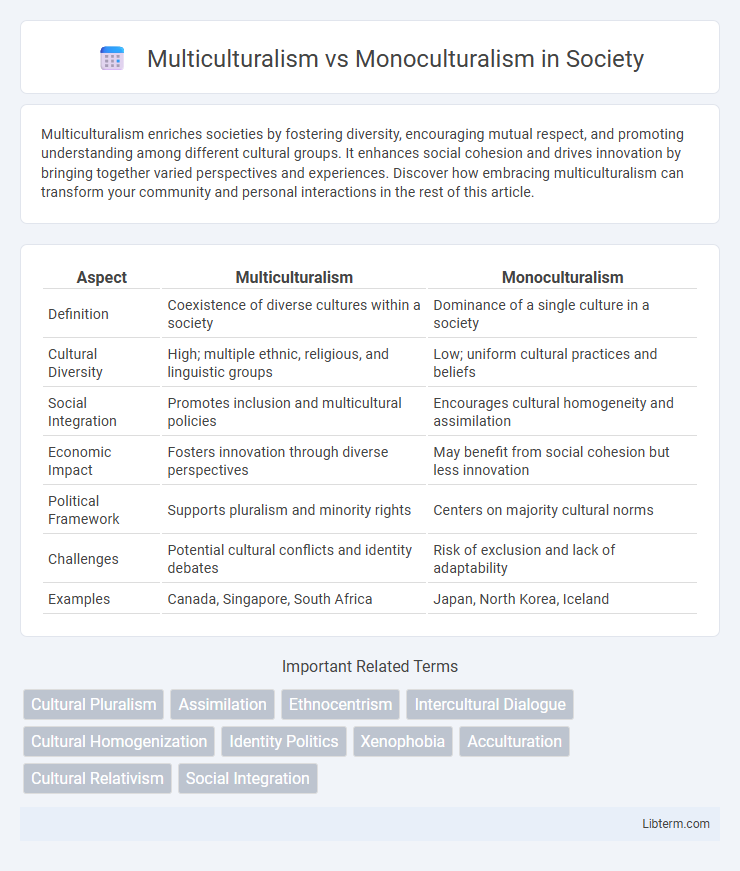Multiculturalism enriches societies by fostering diversity, encouraging mutual respect, and promoting understanding among different cultural groups. It enhances social cohesion and drives innovation by bringing together varied perspectives and experiences. Discover how embracing multiculturalism can transform your community and personal interactions in the rest of this article.
Table of Comparison
| Aspect | Multiculturalism | Monoculturalism |
|---|---|---|
| Definition | Coexistence of diverse cultures within a society | Dominance of a single culture in a society |
| Cultural Diversity | High; multiple ethnic, religious, and linguistic groups | Low; uniform cultural practices and beliefs |
| Social Integration | Promotes inclusion and multicultural policies | Encourages cultural homogeneity and assimilation |
| Economic Impact | Fosters innovation through diverse perspectives | May benefit from social cohesion but less innovation |
| Political Framework | Supports pluralism and minority rights | Centers on majority cultural norms |
| Challenges | Potential cultural conflicts and identity debates | Risk of exclusion and lack of adaptability |
| Examples | Canada, Singapore, South Africa | Japan, North Korea, Iceland |
Understanding Multiculturalism: Definition and Core Principles
Multiculturalism is a social framework that recognizes, respects, and values diverse cultural identities within a unified society, emphasizing inclusivity and equal participation for all cultural groups. Core principles include cultural pluralism, mutual respect, intercultural dialogue, and the promotion of social cohesion through the acceptance of cultural differences. This approach contrasts with monoculturalism, which advocates for a single dominant cultural identity, often limiting cultural expression and diversity.
What is Monoculturalism? Concepts and Characteristics
Monoculturalism refers to the promotion and maintenance of a single cultural identity within a society, emphasizing uniformity in language, traditions, and social norms. It often involves preserving a dominant culture by minimizing cultural diversity and limiting the influence of minority groups. Key characteristics include cultural homogeneity, centralized cultural policies, and resistance to cultural change or pluralism.
Historical Contexts: The Rise of Multicultural and Monocultural Societies
Multiculturalism emerged prominently in the 20th century as global migration increased, fostering societies enriched by diverse cultural backgrounds and ethnicities, particularly in countries like the United States, Canada, and Australia. In contrast, monoculturalism traditionally prevailed in societies with homogeneous populations, often shaped by shared language, religion, and customs, such as Japan and Iceland. Historical events like colonization, economic globalization, and post-war immigration policies have significantly influenced the rise of multicultural and monocultural identities worldwide.
Cultural Diversity: Strengths and Challenges of Multiculturalism
Multiculturalism promotes cultural diversity by fostering increased creativity, innovation, and cross-cultural understanding, which enrich societies economically and socially. Challenges include managing potential social fragmentation, communication barriers, and conflicts arising from differing cultural norms. Effective multicultural policies emphasize inclusion, equal opportunity, and intercultural dialogue to maximize strengths and address such challenges.
Social Cohesion and Unity in Monocultural Societies
Monocultural societies often experience strong social cohesion and unity due to shared values, traditions, and language, which foster a collective identity and mutual trust among members. This homogeneity can simplify governance and create stable social norms that reduce conflicts and misunderstandings. However, while monoculturalism promotes internal solidarity, it may limit exposure to diverse perspectives and reduce adaptability in increasingly globalized contexts.
Impact on Education: Multicultural vs Monocultural Approaches
Multicultural education fosters inclusivity by integrating diverse cultural perspectives into the curriculum, enhancing critical thinking and empathy among students. Monocultural education often centers on a single cultural narrative, which can limit students' global awareness and reduce exposure to varied viewpoints. Research shows that multicultural approaches improve student engagement and prepare learners for a diverse, interconnected world.
Economic Effects: Workforce Diversity and Innovation
Workforce diversity in multicultural societies drives innovation by combining varied perspectives and problem-solving approaches, leading to increased creativity and competitiveness in global markets. Monocultural workforces may face limitations in adaptability and innovative capacity due to homogeneous thinking patterns and reduced exposure to different cultural insights. Economically, diverse teams contribute to higher productivity and better decision-making, enhancing overall business performance and market reach.
Citizenship, Identity, and Belonging in Diverse Societies
Multiculturalism promotes inclusive citizenship by recognizing and valuing diverse cultural identities within a society, fostering a sense of belonging among minority groups. Monoculturalism emphasizes a unified national identity, often prioritizing a single cultural narrative that can marginalize diverse voices and limit social cohesion. Balancing these approaches impacts social integration, policy development, and the evolution of collective identity in increasingly diverse populations.
Conflict, Integration, and Policy Responses
Multiculturalism fosters social integration by promoting cultural pluralism and inclusive policies that mitigate conflict through dialogue and representation, whereas monoculturalism often leads to social tension by enforcing cultural homogeneity and marginalizing minority groups. Conflict arises in monocultural settings due to resistance against cultural assimilation, while multicultural frameworks implement policy responses such as anti-discrimination laws and multicultural education to enhance social cohesion. Effective policy measures in diverse societies include affirmative action programs, legal protections for minority rights, and community engagement initiatives that support harmonious coexistence and reduce cultural clashes.
The Future of Societies: Navigating Multiculturalism and Monoculturalism
The future of societies hinges on balancing the dynamic interplay between multiculturalism and monoculturalism, where embracing cultural diversity fosters innovation, social cohesion, and economic growth. Monoculturalism emphasizes cultural preservation and identity stability, yet risks social fragmentation and limited adaptability in globalized environments. Successful navigation requires policies promoting inclusive dialogue, equitable resource distribution, and intercultural competence to harness diversity's benefits while respecting cultural heritage.
Multiculturalism Infographic

 libterm.com
libterm.com